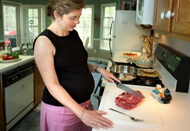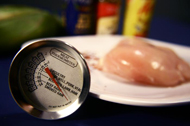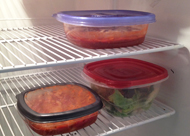Warmer weather can easily cause food to spoil. Cooking meats to a proper internal temperature and keeping hot foods hot and cold foods cool helps stop foodborne bacteria from growing.

Following these four simple steps can help keep you and your family safe from food poisoning at home.
CLEAN: Wash hands and surfaces often
Illness-causing bacteria and viruses can survive in many places around your kitchen, including your hands, utensils and cutting boards. Unless you wash your hands, utensils and surfaces the right way, you could spread these germs to your food and your family.
- Wash hands the right way—for 20 seconds with soap and running water. Be sure to scrub the backs of your hands, between your fingers, and under your nails.
- Wash surfaces and utensils after each use. Rinsing utensils, countertops and cutting boards with water won’t do enough to stop bacteria from spreading. Clean utensils and small cutting boards with hot, soapy water. Clean surfaces and cutting boards with a bleach solution.
- Wash fruits and veggies—but not meat, poultry, or eggs. Even if you plan to peel fruits and veggies, it’s important to wash them first because bacteria and viruses can spread from the outside to the inside as you cut or peel them.
SEPARATE: Don’t cross-contaminate
Even after you’ve cleaned your hands and surfaces thoroughly, raw meat, poultry, seafood and eggs can still spread illness-causing germs to ready-to-eat foods—unless you keep them separate.
- Use separate cutting boards, plates, and utensils for raw (uncooked) produce and for raw (uncooked) meat, poultry, seafood and eggs.
- Keep meat, poultry, seafood and eggs separate from all other foods while you’re shopping at the grocery store.
- Keep meat, poultry, seafood and eggs separate from all other foods in the refrigerator.
COOK: Cook to the right temperature
One of the basics of food safety is cooking food to its proper temperature. Foods are properly cooked when they are heated for a long enough time and at a high enough temperature to kill the harmful bacteria and viruses that cause foodborne illness.
While many people think they can tell when food is “done” simply by checking its color and texture, there’s no way to be sure it’s safe without following a few important but simple steps.
- Use a food thermometer. Make sure food reaches its safe minimum cooking temperature (pdf). Internal temperatures should be:
- 145°F for beef, pork, veal and lamb (roast, steak and chops). Allow the meat to rest for 3 minutes before carving or eating.
- 160°F for ground meats
- 165°F for all poultry
- 145°F for fin fish
- Refer to this handout for safe cooking of shellfish including oysters, clams and mussels (pdf)
- Eggs should be cooked until both the yolk and white are firm, egg dishes should be 160°F
- During meal times, while food is being served and eaten, keep it hot (at 140°F or above). After meals are over, refrigerate leftover food quickly.
- Microwave food thoroughly (to 165°F).
CHILL: Refrigerate promptly
Illness-causing bacteria and viruses can grow in many foods within two hours unless you refrigerate them. During the summer heat, cut that time down to one hour.
- Refrigerate the foods that tend to spoil more quickly (like fruits and vegetables, milk, eggs and meats) within two hours. Warm foods will chill faster if they are divided into several clean, shallow containers.
- Thaw or marinate foods in the refrigerator, never on the counter or in the kitchen sink.
- Know when to throw food out.
To learn more, visit the Oregon Health Authority.



